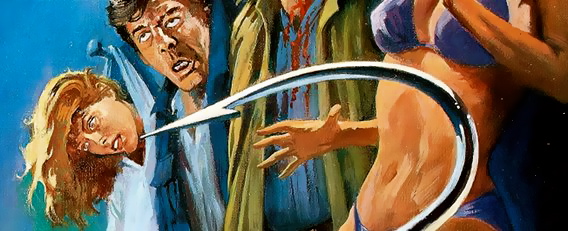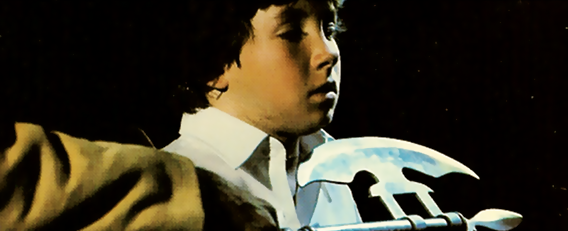
Critics may scoff and most film fans may turn their noses up at them, but the slasher genre is the perfect training ground for a young, wannabe filmmaker. With an almost non-existent budget, a simple premise, aided by a likeable cast and some inventive special effects, can result in a modest performance at the box office. It is the one genre that was at its most lucrative outside of the studio system; Friday the 13th was produced without the assistance of Paramount Pictures, who later purchased the film and ran an extensive publicity campaign, and John Carpenter’s independent hit Halloween would inspire a generation of filmmakers to shoot their own cheap thrillers. Elsewhere, The Dorm That Dripped Blood was created by a group of UCLA students, using whatever resources were available. The slasher genre of the 1980s was far more creative than detractors would give credit to, and it was with a similar attitude that Buddy Cooper would shoot his own low budget offering, The Mutilator.
Working as a lawyer in his native North Carolina, Cooper had begun to express interest in the film industry and, in 1982, had taken part in a two-week screenwriting course at the American University of Washington, D.C., where he had learned the basics of filmmaking under the guidance of his tutor, Jack Douglass. It was during this time that he began to develop his first script, Fall Break, which had been conceived over Labor Day Weekend when he had taken a walk across a beach with a friend and had suggested a variety of fishing and water implements that could be used as effective weapons in a horror picture. Balancing his writing chores with his legal obligations, Cooper completed his first draft in a little under four weeks and, with the assistance of Douglass, began to perform various rewrites in order to strengthen characters and amend inconsistencies.
Cooper had no delusions as to what kind of film he had written and had intended on shooting the project in just a couple of weeks with the help of friends, but after making the acquaintance of cinematographer Peter Schnall, Cooper was eventually convinced to seek out professional assistance. The budget would soon increase, forcing Cooper to max out two credit cards in an attempt to keep the production moving, as well as taking out a loan from Wachovia Bank. The twenty-nine day shoot commenced on Atlantic Beach and in Morehead City, North Carolina, on May 4th 1983 and featured a cast of mostly inexperienced actors. The one exception would be Ben Moore, a veteran of several Herschell Gordon Lewis movies, including his 1964 splatter classic Two Thousand Maniacs!. Moore had been a friend of Cooper’s for many years and had grown up in Morehead. When he had learned of Fall Break, he had repeatedly asked Cooper to allow him to try out for one of the roles, eventually landing the part of a cop who is dispatched early on in the film.

The screenplay would require the usual types of actors associated with slasher films; twenty-somethings who are more interested in partying and making out than using their common sense. Having accidentally killed his mother when he was a child, Ed has become alienated from his father and so is surprised when he receives a message from him requesting that he travel to the beach to close his condo for the winter. Excited at the chance of a weekend away, his friends agree to join him but are unaware that his father is lurking in the shadows, thirsty for revenge. Most of the roles would be cast locally, although leads Matt Mitler (who would portray Ed) and Frances Raines were found in New York. The part of Big Ed, Mitler’s on-screen father, would go to ex-teacher Jack Chatham, who would attend his audition dressed in character. The other principal roles, mostly those of Ed’s friends, would go to various North Carolina-based actors, including Bill Hitchcock who, after several years of success in the industry, eventually turned to real estate.
With the selling point of many slashers being the gruesome murders, Cooper recruited a talented team of special effects artists to create the memorable set pieces. Mark Shostrom, whose first credit had been on the David Hess-directed slasher To All a Goodnight in 1980, would be responsible for supervising the various gags, although due to unforeseen circumstances some of these would either be reworked or cut all together. One of the more memorable deaths would feature Morey Lampley, in the role of Mike, who would be fitted with a foam latex appliance for a scene in which he was disembowelled by an outboard motor. But the standout sequence would be reserved for the demise of Big Ed, who would be split in two during the film’s gory climax. Although a dummy would prove to be unconvincing, the effect would be achieved by Chatham being buried to his waist, an unpleasant experience that the actor would be subjected to for several hours. With only brief footage of the dummy shown in the final cut, the scene would be a success due to both Chatham’s over-the-top performance and the editing, which was overseen by Stephen Mack and his assistant (and sound editor) Hughes Winborne.
Although the name of the movie would eventually be changed to The Mutilator, a song entitled Fall Break would be composed by Michael Minard. Co-written by Arthur Resnick, whose biggest hit had come twenty years earlier with the soul classic Under the Boardwalk, the track would be credited to Peter Yellen and The Breakers (the end credits would identity Cooper as a member). The Mutilator enjoyed modest success on home video during the 1980s, mostly due to its elaborate and original death scenes, particularly as it was released at a time when the slasher film had begun to grow tame and uninspired. Unfortunately, its treatment on DVD has been less-than-impressive, with disappointing releases from Dragon and VIPCO either providing censored or poor quality prints. Meanwhile, the long-promised Code Red release has yet to surface.


12 Responses to By Sword, By Pick, By Axe: The Making of The Mutilator